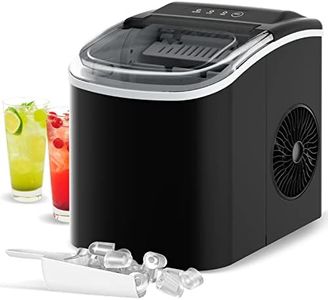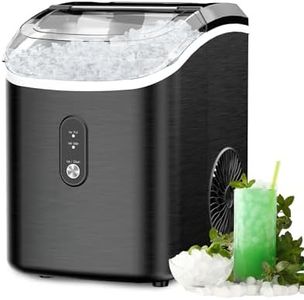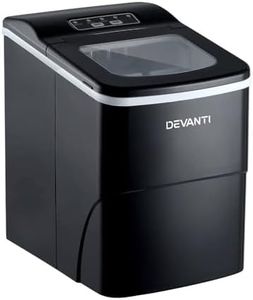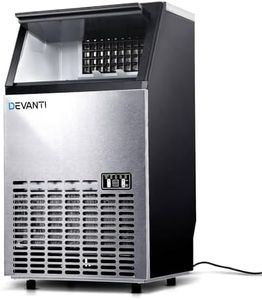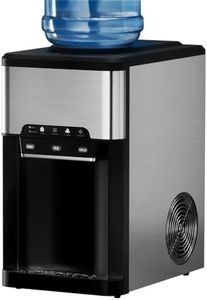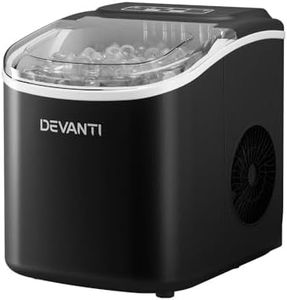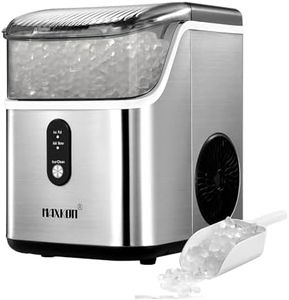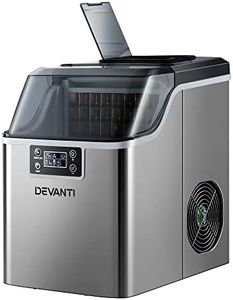We Use CookiesWe use cookies to enhance the security, performance,
functionality and for analytical and promotional activities. By continuing to browse this site you
are agreeing to our privacy policy
10 Best Countertop Ice Makers
From leading brands and best sellers available on the web.Buying Guide for the Best Countertop Ice Makers
When choosing a countertop ice maker, it's important to match your selection to your lifestyle and intended use. These machines are great for homes, offices, or small gatherings where you want fresh ice on demand without relying on your freezer. The right model will depend on how much ice you need, how quickly you want it, and the available space on your counter. Understanding the key specifications will help you avoid picking a machine that's too slow, too bulky, or doesn’t fit your typical ice needs.Ice Production CapacityIce production capacity refers to how much ice the machine can make in a 24-hour period. This is important because it tells you whether the ice maker can keep up with your needs, especially if you often host guests or use a lot of ice daily. Small capacity machines might produce around 20 pounds or less per day, which suits a single person or couple. Medium capacity units (20–30 pounds per day) are good for families or small gatherings. High-capacity models (30 pounds and above per day) are better for parties, offices, or large households. Think about how much ice you typically use in a day and pick a machine that matches or exceeds this amount.
Ice Cycle TimeIce cycle time is how long the machine takes to make a batch of ice, usually measured in minutes per cycle. This matters if you want ice quickly or if you’re entertaining and need frequent refills. Most machines offer cycle times ranging from 6 to 15 minutes. Shorter cycles mean you'll have fresh ice faster, which is great if you're impatient or hosting a larger group. If you only need occasional ice, longer cycles may be just fine. Match the cycle time to your expectations for waiting and how quickly you'll need to replenish your supply.
Ice Storage CapacityIce storage capacity is how much ice the machine’s tray or bin can hold before you need to remove it. This is useful because even if a machine makes a lot of ice in a day, its storage bin may fill up quickly. Smaller storage bins (1–1.5 pounds) mean you’ll need to empty the ice more often, while larger bins (2 pounds or more) let you leave the ice until you’re ready to use it all at once. Consider how often you want to interact with the machine—frequent party hosts might prioritize larger storage, while those who use ice occasionally may not mind smaller bins.
Ice Shape and Size OptionsDifferent machines produce different shapes and sizes of ice, such as bullet, cube, or nugget forms. This spec affects your enjoyment and the drink’s cooling efficiency. Some models let you choose between small and large pieces, or even different shapes. If you have a particular preference or use ice for specific drinks (like cocktails, smoothies, or iced coffee), pay attention to shape and size options. If you’re not picky, a single-shape machine is sufficient, but flexible ice size controls add versatility for varied needs.
Machine Size and PortabilityThe physical footprint and weight of a countertop ice maker matter if you have limited counter space or plan to move it often. Compact models are easier to store and transport, suitable for people with small kitchens or those who want to take their machine to parties or camping. Larger units often have greater capacity but take up more space. Measure your available space before buying, and consider whether you’ll frequently relocate the machine or prefer it to stay in one spot.
Ease of CleaningKeeping your ice maker clean is important for hygiene and long-term performance. Some units have self-cleaning functions, while others require manual cleaning. If you want minimal effort, look for a model with an automatic cleaning feature. If you don’t mind a bit of regular maintenance, a model with easily removable parts for manual cleaning works fine. People who plan to use the ice maker daily should prioritize easy cleaning to avoid buildup and keep ice-tasting fresh.
Operating Noise LevelIce makers can generate noise while running, which might be bothersome in quiet environments like bedrooms or offices. Noise levels can range from a gentle hum to louder motor sounds. If you’re sensitive to noise or plan to use the machine in a quiet setting, seek out models known for quiet operation. If you’ll use it in busy kitchens or party areas, noise may not be a big concern.


